In this post we will implement Single and Multiple Fileupload functionality using Spring MultipartResolver implementation StandardServletMultipartResolver in Servlet 3 environments. Spring provides build-in multipart support to handle file uploads in a web application.
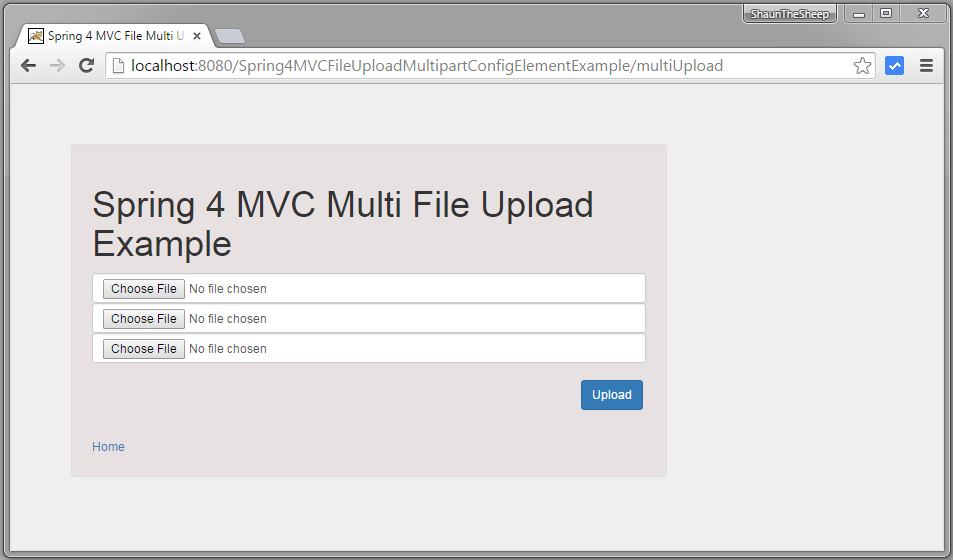
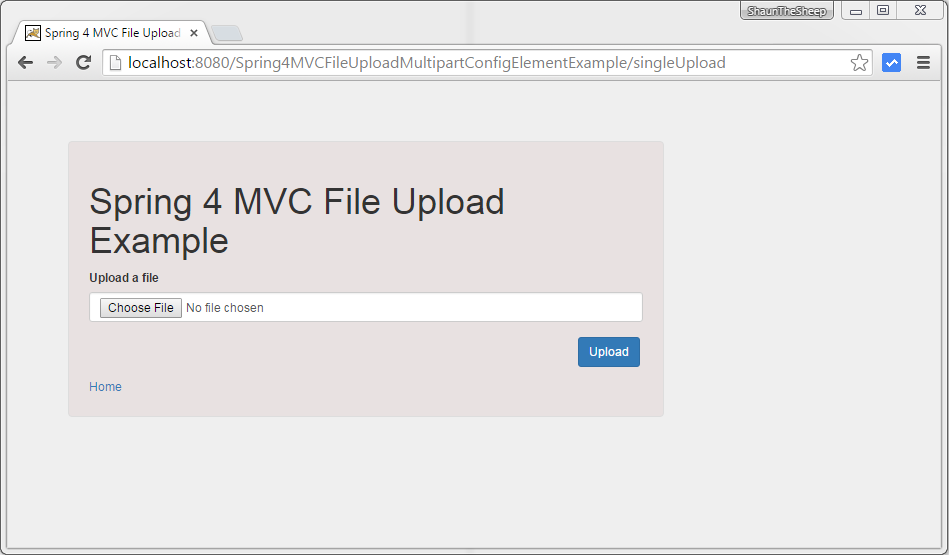
Let’s get started.
- Spring Boot+AngularJS+Spring Data+Hibernate+MySQL CRUD App
- Spring Boot REST API Tutorial
- Spring Boot WAR deployment example
- Secure Spring REST API using OAuth2
- Spring Boot Introduction + Hello World Example
- AngularJS+Spring Security using Basic Authentication
- Secure Spring REST API using Basic Authentication
- Spring 4 Caching Annotations Tutorial
- Spring 4 Cache Tutorial with EhCache
- Spring 4 MVC+JPA2+Hibernate Many-to-many Example
- Spring 4 Email Template Library Example
- Spring 4 Email With Attachment Tutorial
- Spring 4 Email Integration Tutorial
- Spring MVC 4+JMS+ActiveMQ Integration Example
- Spring 4+JMS+ActiveMQ @JmsLister @EnableJms Example
- Spring MVC 4+Spring Security 4 + Hibernate Integration Example
- Spring 4+JMS+ActiveMQ Integration Example
- Spring MVC 4+AngularJS Example
- Spring MVC 4+AngularJS Server communication example : CRUD application using ngResource $resource service
- Spring MVC 4+AngularJS Routing with UI-Router Example
- Spring MVC 4+AngularJS Routing with ngRoute Example
- Spring MVC4 FileUpload-Download Hibernate+MySQL Example
- Spring MVC 4 File Upload Example using Commons fileupload
- Spring MVC 4 File Download Example
Short Overview
Previous post showed file upload using CommonsMultipartResolver. That implementations works well even in Servlet 3.0 environment. In this post, we will implement same example again, but using Servlet 3.0 specific javax.servlet.MultipartConfigElement
In order to activate Multipart support with Spring in Servlet 3.0 environment, you need to do following
1. Add StandardServletMultipartResolver Bean to your Spring Configuration.It’s a standard implementation of the MultipartResolver interface, based on the Servlet 3.0 javax.servlet.http.Part API.
2. Enable MultiParsing in Servlet 3.0 environments. To do that, You have several choices to choose from.
-
Choice A. Set
javax.servlet.MultipartConfigElementin programmatic Servlet registration. MultipartConfigElement is simply Java Class representation of anjavax.servlet.annotation.MultipartConfigannotation value (as described in choice c). This post will focus specially on this choice. -
Choice B. If you are using XML based configuration, you can declare
multipart-configsection under servlet configuration in web.xml, as shown below:<servlet> <servlet-name>SpringDispatcher</servlet-name> <servlet-class>org.springframework.web.servlet.DispatcherServlet</servlet-class> <multipart-config> <location>/tmp</location> <max-file-size>5242880</max-file-size><!--5MB--> <max-request-size>20971520</max-request-size><!--20MB--> <file-size-threshold>0</file-size-threshold> </multipart-config> </servlet> -
Choice C. You can create a custom Servlet and annotate it with
javax.servlet.annotation.MultipartConfigannotation as shown below:@WebServlet(name = "fileUploadServlet", urlPatterns = {"/upload"}) @MultipartConfig(location=/tmp, fileSizeThreshold=0, maxFileSize=5242880, // 5 MB maxRequestSize=20971520) // 20 MB public class FileUploadServlet extends HttpServlet { protected void doPost(HttpServletRequest request, HttpServletResponse response) throws ServletException, IOException { //handle file upload }
That being said, we will focus on Choice A in this example.
Complete Example
Following technologies being used:
- Spring 4.2.0.RELEASE
- validation-api 1.1.0.Final
- Bootstrap v3.3.2
- Maven 3
- JDK 1.7
- Tomcat 8.0.21
- Eclipse JUNO Service Release 2
Let’s begin.
Project Structure
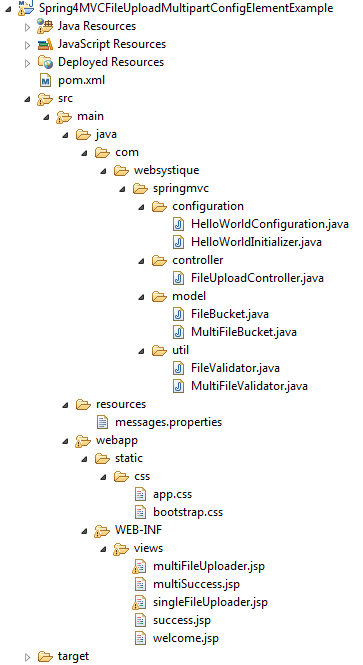
Declare dependencies in pom.xml
<project xmlns="http://maven.apache.org/POM/4.0.0" xmlns:xsi="http://www.w3.org/2001/XMLSchema-instance"
xsi:schemaLocation="http://maven.apache.org/POM/4.0.0 http://maven.apache.org/maven-v4_0_0.xsd">
<modelVersion>4.0.0</modelVersion>
<groupId>com.websystique.springmvc</groupId>
<artifactId>Spring4MVCFileUploadMultipartResolverExample</artifactId>
<packaging>war</packaging>
<version>1.0.0</version>
<name>Spring4MVCFileUploadMultipartConfigElementExample Maven Webapp</name>
<url>http://maven.apache.org</url>
<properties>
<springframework.version>4.2.0.RELEASE</springframework.version>
</properties>
<dependencies>
<dependency>
<groupId>org.springframework</groupId>
<artifactId>spring-webmvc</artifactId>
<version>${springframework.version}</version>
</dependency>
<dependency>
<groupId>javax.validation</groupId>
<artifactId>validation-api</artifactId>
<version>1.1.0.Final</version>
</dependency>
<dependency>
<groupId>javax.servlet</groupId>
<artifactId>javax.servlet-api</artifactId>
<version>3.1.0</version>
</dependency>
<dependency>
<groupId>javax.servlet</groupId>
<artifactId>jstl</artifactId>
<version>1.2</version>
</dependency>
</dependencies>
<build>
<pluginManagement>
<plugins>
<plugin>
<groupId>org.apache.maven.plugins</groupId>
<artifactId>maven-compiler-plugin</artifactId>
<version>3.2</version>
<configuration>
<source>1.7</source>
<target>1.7</target>
</configuration>
</plugin>
<plugin>
<groupId>org.apache.maven.plugins</groupId>
<artifactId>maven-war-plugin</artifactId>
<version>2.4</version>
<configuration>
<warSourceDirectory>src/main/webapp</warSourceDirectory>
<warName>Spring4MVCFileUploadMultipartConfigElementExample</warName>
<failOnMissingWebXml>false</failOnMissingWebXml>
</configuration>
</plugin>
</plugins>
</pluginManagement>
<finalName>Spring4MVCFileUploadMultipartConfigElementExample</finalName>
</build>
</project>
Programmatic Registration of MultiPartConfigElement
This registration provides opportunity to set specific properties like maximum filesize, request size, location and threshold after which file will be stored temporarily on disk during upload operation.
package com.websystique.springmvc.configuration;
import javax.servlet.MultipartConfigElement;
import javax.servlet.ServletRegistration;
import org.springframework.web.servlet.support.AbstractAnnotationConfigDispatcherServletInitializer;
public class HelloWorldInitializer extends
AbstractAnnotationConfigDispatcherServletInitializer {
@Override
protected Class<?>[] getRootConfigClasses() {
return new Class[] { HelloWorldConfiguration.class };
}
@Override
protected Class<?>[] getServletConfigClasses() {
return null;
}
@Override
protected String[] getServletMappings() {
return new String[] { "/" };
}
@Override
protected void customizeRegistration(ServletRegistration.Dynamic registration) {
registration.setMultipartConfig(getMultipartConfigElement());
}
private MultipartConfigElement getMultipartConfigElement() {
MultipartConfigElement multipartConfigElement = new MultipartConfigElement( LOCATION, MAX_FILE_SIZE, MAX_REQUEST_SIZE, FILE_SIZE_THRESHOLD);
return multipartConfigElement;
}
private static final String LOCATION = "C:/temp/"; // Temporary location where files will be stored
private static final long MAX_FILE_SIZE = 5242880; // 5MB : Max file size.
// Beyond that size spring will throw exception.
private static final long MAX_REQUEST_SIZE = 20971520; // 20MB : Total request size containing Multi part.
private static final int FILE_SIZE_THRESHOLD = 0; // Size threshold after which files will be written to disk
}
Notice how we have overridden function customizeRegistration in order to register the required MultiPartConfigElement to DispatcherServlet.
Create Configuration
Configure StandardServletMultipartResolver Bean. It’s a standard implementation of the MultipartResolver interface, based on the Servlet 3.0 javax.servlet.http.Part API.
package com.websystique.springmvc.configuration;
import org.springframework.context.MessageSource;
import org.springframework.context.annotation.Bean;
import org.springframework.context.annotation.ComponentScan;
import org.springframework.context.annotation.Configuration;
import org.springframework.context.support.ResourceBundleMessageSource;
import org.springframework.web.multipart.support.StandardServletMultipartResolver;
import org.springframework.web.servlet.config.annotation.EnableWebMvc;
import org.springframework.web.servlet.config.annotation.ResourceHandlerRegistry;
import org.springframework.web.servlet.config.annotation.ViewResolverRegistry;
import org.springframework.web.servlet.config.annotation.WebMvcConfigurerAdapter;
import org.springframework.web.servlet.view.InternalResourceViewResolver;
import org.springframework.web.servlet.view.JstlView;
@Configuration
@EnableWebMvc
@ComponentScan(basePackages = "com.websystique.springmvc")
public class HelloWorldConfiguration extends WebMvcConfigurerAdapter {
@Bean(name = "multipartResolver")
public StandardServletMultipartResolver resolver() {
return new StandardServletMultipartResolver();
}
@Override
public void configureViewResolvers(ViewResolverRegistry registry) {
InternalResourceViewResolver viewResolver = new InternalResourceViewResolver();
viewResolver.setViewClass(JstlView.class);
viewResolver.setPrefix("/WEB-INF/views/");
viewResolver.setSuffix(".jsp");
registry.viewResolver(viewResolver);
}
@Bean
public MessageSource messageSource() {
ResourceBundleMessageSource messageSource = new ResourceBundleMessageSource();
messageSource.setBasename("messages");
return messageSource;
}
@Override
public void addResourceHandlers(ResourceHandlerRegistry registry) {
registry.addResourceHandler("/static/**").addResourceLocations( "/static/");
}
}
This Configuration class in XML format will be:
<beans xmlns="http://www.springframework.org/schema/beans"
xmlns:context="http://www.springframework.org/schema/context"
xmlns:xsi="http://www.w3.org/2001/XMLSchema-instance"
xmlns:mvc="http://www.springframework.org/schema/mvc"
xsi:schemaLocation="http://www.springframework.org/schema/beans http://www.springframework.org/schema/beans/spring-beans-4.0.xsd
http://www.springframework.org/schema/mvc http://www.springframework.org/schema/mvc/spring-mvc-4.0.xsd
http://www.springframework.org/schema/context http://www.springframework.org/schema/context/spring-context-4.0.xsd">
<context:component-scan base-package="com.websystique.springmvc" />
<mvc:annotation-driven />
<bean id="multipartResolver" class="org.springframework.web.multipart.support.StandardServletMultipartResolver"/>
<mvc:resources mapping="/static/**" location="/static/" />
<mvc:default-servlet-handler />
<bean id="messageSource" class="org.springframework.context.support.ResourceBundleMessageSource">
<property name="basename">
<value>messages</value>
</property>
</bean>
<bean class="org.springframework.web.servlet.view.InternalResourceViewResolver">
<property name="prefix">
<value>/WEB-INF/views/</value>
</property>
<property name="suffix">
<value>.jsp</value>
</property>
</bean>
</beans>
Create Model classes
Spring provides org.springframework.web.multipart.MultipartFile which is a representation of an uploaded file received in a multipart request. It provides handy methods like getName(), getContentType(), getBytes(), getInputStream() etc.. which make life bit easier while retrieving information about file being uploaded.
Let’s write a wrapper class to further simply it’s usage in our application
package com.websystique.springmvc.model;
import org.springframework.web.multipart.MultipartFile;
public class FileBucket {
MultipartFile file;
public MultipartFile getFile() {
return file;
}
public void setFile(MultipartFile file) {
this.file = file;
}
}
To demonstrate Multiple uploads example as well, let’s create one more wrapper class.
package com.websystique.springmvc.model;
import java.util.ArrayList;
import java.util.List;
public class MultiFileBucket {
List<FileBucket> files = new ArrayList<FileBucket>();
public MultiFileBucket(){
files.add(new FileBucket());
files.add(new FileBucket());
files.add(new FileBucket());
}
public List<FileBucket> getFiles() {
return files;
}
public void setFiles(List<FileBucket> files) {
this.files = files;
}
}
This class can handle up to 3 file uploads.
Create Controller
package com.websystique.springmvc.controller;
import java.io.File;
import java.io.IOException;
import java.util.ArrayList;
import java.util.List;
import javax.validation.Valid;
import org.springframework.beans.factory.annotation.Autowired;
import org.springframework.stereotype.Controller;
import org.springframework.ui.ModelMap;
import org.springframework.util.FileCopyUtils;
import org.springframework.validation.BindingResult;
import org.springframework.web.bind.WebDataBinder;
import org.springframework.web.bind.annotation.InitBinder;
import org.springframework.web.bind.annotation.RequestMapping;
import org.springframework.web.bind.annotation.RequestMethod;
import org.springframework.web.multipart.MultipartFile;
import com.websystique.springmvc.model.FileBucket;
import com.websystique.springmvc.model.MultiFileBucket;
import com.websystique.springmvc.util.FileValidator;
import com.websystique.springmvc.util.MultiFileValidator;
@Controller
public class FileUploadController {
private static String UPLOAD_LOCATION="C:/mytemp/";
@Autowired
FileValidator fileValidator;
@Autowired
MultiFileValidator multiFileValidator;
@InitBinder("fileBucket")
protected void initBinderFileBucket(WebDataBinder binder) {
binder.setValidator(fileValidator);
}
@InitBinder("multiFileBucket")
protected void initBinderMultiFileBucket(WebDataBinder binder) {
binder.setValidator(multiFileValidator);
}
@RequestMapping(value = { "/", "/welcome" }, method = RequestMethod.GET)
public String getHomePage(ModelMap model) {
return "welcome";
}
@RequestMapping(value = "/singleUpload", method = RequestMethod.GET)
public String getSingleUploadPage(ModelMap model) {
FileBucket fileModel = new FileBucket();
model.addAttribute("fileBucket", fileModel);
return "singleFileUploader";
}
@RequestMapping(value = "/singleUpload", method = RequestMethod.POST)
public String singleFileUpload(@Valid FileBucket fileBucket,
BindingResult result, ModelMap model) throws IOException {
if (result.hasErrors()) {
System.out.println("validation errors");
return "singleFileUploader";
} else {
System.out.println("Fetching file");
MultipartFile multipartFile = fileBucket.getFile();
// Now do something with file...
FileCopyUtils.copy(fileBucket.getFile().getBytes(), new File( UPLOAD_LOCATION + fileBucket.getFile().getOriginalFilename()));
String fileName = multipartFile.getOriginalFilename();
model.addAttribute("fileName", fileName);
return "success";
}
}
@RequestMapping(value = "/multiUpload", method = RequestMethod.GET)
public String getMultiUploadPage(ModelMap model) {
MultiFileBucket filesModel = new MultiFileBucket();
model.addAttribute("multiFileBucket", filesModel);
return "multiFileUploader";
}
@RequestMapping(value = "/multiUpload", method = RequestMethod.POST)
public String multiFileUpload(@Valid MultiFileBucket multiFileBucket,
BindingResult result, ModelMap model) throws IOException {
if (result.hasErrors()) {
System.out.println("validation errors in multi upload");
return "multiFileUploader";
} else {
System.out.println("Fetching files");
List<String> fileNames = new ArrayList<String>();
// Now do something with file...
for (FileBucket bucket : multiFileBucket.getFiles()) {
FileCopyUtils.copy(bucket.getFile().getBytes(), new File(UPLOAD_LOCATION + bucket.getFile().getOriginalFilename()));
fileNames.add(bucket.getFile().getOriginalFilename());
}
model.addAttribute("fileNames", fileNames);
return "multiSuccess";
}
}
}
Above controller is fairly trivial. It handles GET and POST request for file upload view. Once file is selected from File picker and user clicked on upload, we are simply creating a new file with the same name and bytes content as original file, copying the bytes from original file. For that we are using Spring FileCopyUtils utility class to copy stream from source to destination. In this example, we have specified destination as C:/mytemp folder, all files will end up in this folder.
Create Validators classes
We are using some Validators to verify that user have indeed selected a file to be uploaded. They are shown below.
package com.websystique.springmvc.util;
import org.springframework.stereotype.Component;
import org.springframework.validation.Errors;
import org.springframework.validation.Validator;
import com.websystique.springmvc.model.FileBucket;
@Component
public class FileValidator implements Validator {
public boolean supports(Class<?> clazz) {
return FileBucket.class.isAssignableFrom(clazz);
}
public void validate(Object obj, Errors errors) {
FileBucket file = (FileBucket) obj;
if(file.getFile()!=null){
if (file.getFile().getSize() == 0) {
errors.rejectValue("file", "missing.file");
}
}
}
}
package com.websystique.springmvc.util;
import org.springframework.stereotype.Component;
import org.springframework.validation.Errors;
import org.springframework.validation.Validator;
import com.websystique.springmvc.model.FileBucket;
import com.websystique.springmvc.model.MultiFileBucket;
@Component
public class MultiFileValidator implements Validator {
public boolean supports(Class<?> clazz) {
return MultiFileBucket.class.isAssignableFrom(clazz);
}
public void validate(Object obj, Errors errors) {
MultiFileBucket multiBucket = (MultiFileBucket) obj;
int index=0;
for(FileBucket file : multiBucket.getFiles()){
if(file.getFile()!=null){
if (file.getFile().getSize() == 0) {
errors.rejectValue("files["+index+"].file", "missing.file");
}
}
index++;
}
}
}
messages.properties
missing.file= Please select a file.
Create Views
singleFileUploader.jsp
<%@ page language="java" contentType="text/html; charset=ISO-8859-1" pageEncoding="ISO-8859-1"%> <%@ taglib prefix="c" uri="http://java.sun.com/jsp/jstl/core"%> <%@ taglib prefix="form" uri="http://www.springframework.org/tags/form"%> <html> <head> <meta http-equiv="Content-Type" content="text/html; charset=ISO-8859-1"> <title>Spring 4 MVC File Upload Example</title> <link href="<c:url value='/static/css/bootstrap.css' />" rel="stylesheet" type="text/css"></link> <link href="<c:url value='/static/css/app.css' />" rel="stylesheet" type="text/css"></link> </head> <body> <div class="form-container"> <h1>Spring 4 MVC File Upload Example </h1> <form:form method="POST" modelAttribute="fileBucket" enctype="multipart/form-data" class="form-horizontal"> <div class="row"> <div class="form-group col-md-12"> <label class="col-md-3 control-lable" for="file">Upload a file</label> <div class="col-md-7"> <form:input type="file" path="file" id="file" class="form-control input-sm"/> <div class="has-error"> <form:errors path="file" class="help-inline"/> </div> </div> </div> </div> <div class="row"> <div class="form-actions floatRight"> <input type="submit" value="Upload" class="btn btn-primary btn-sm"> </div> </div> </form:form> <a href="<c:url value='/welcome' />">Home</a> </div> </body> </html>
success.jsp
<%@ page language="java" contentType="text/html; charset=ISO-8859-1" pageEncoding="ISO-8859-1"%>
<%@ taglib prefix="c" uri="http://java.sun.com/jsp/jstl/core" %>
<html>
<head>
<meta http-equiv="Content-Type" content="text/html; charset=ISO-8859-1">
<title>File Upload Success</title>
<link href="<c:url value='/static/css/bootstrap.css' />" rel="stylesheet"></link>
<link href="<c:url value='/static/css/app.css' />" rel="stylesheet"></link>
</head>
<body>
<div class="success">
File <strong>${fileName}</strong> uploaded successfully.
<br/><br/>
<a href="<c:url value='/welcome' />">Home</a>
</div>
</body>
</html>
multiFileUploader.jsp
<%@ page language="java" contentType="text/html; charset=ISO-8859-1" pageEncoding="ISO-8859-1"%>
<%@ taglib prefix="c" uri="http://java.sun.com/jsp/jstl/core"%>
<%@ taglib prefix="form" uri="http://www.springframework.org/tags/form"%>
<html>
<head>
<meta http-equiv="Content-Type" content="text/html; charset=ISO-8859-1">
<title>Spring 4 MVC File Multi Upload Example</title>
<link href="<c:url value='/static/css/bootstrap.css' />" rel="stylesheet" type="text/css"></link>
<link href="<c:url value='/static/css/app.css' />" rel="stylesheet" type="text/css"></link>
</head>
<body>
<div class="form-container">
<h1>Spring 4 MVC Multi File Upload Example </h1>
<form:form method="POST" modelAttribute="multiFileBucket" enctype="multipart/form-data" class="form-horizontal">
<c:forEach var="v" varStatus="vs" items="${multiFileBucket.files}">
<form:input type="file" path="files[${vs.index}].file" id="files[${vs.index}].file" class="form-control input-sm"/>
<div class="has-error">
<form:errors path="files[${vs.index}].file" class="help-inline"/>
</div>
</c:forEach>
<br/>
<div class="row">
<div class="form-actions floatRight">
<input type="submit" value="Upload" class="btn btn-primary btn-sm">
</div>
</div>
</form:form>
<br/>
<a href="<c:url value='/welcome' />">Home</a>
</div>
</body>
</html>
multiSuccess.jsp
<%@ page language="java" contentType="text/html; charset=ISO-8859-1" pageEncoding="ISO-8859-1"%>
<%@ taglib prefix="c" uri="http://java.sun.com/jsp/jstl/core" %>
<html>
<head>
<meta http-equiv="Content-Type" content="text/html; charset=ISO-8859-1">
<title>File Upload Success</title>
<link href="<c:url value='/static/css/bootstrap.css' />" rel="stylesheet"></link>
<link href="<c:url value='/static/css/app.css' />" rel="stylesheet"></link>
</head>
<body>
<div class="success">
<c:forEach var="fileName" items="${fileNames}">
File <strong>${fileName}</strong> uploaded successfully<br/>
</c:forEach>
<br/>
<a href="<c:url value='/welcome' />">Home</a>
</div>
</body>
</html>
welcome.jsp
<%@ taglib prefix="form" uri="http://www.springframework.org/tags/form"%> <%@ taglib prefix="c" uri="http://java.sun.com/jsp/jstl/core" %> <html> <head> <meta http-equiv="Content-Type" content="text/html; charset=ISO-8859-1"> <title>Spring 4 MVC File Upload Example</title> <link href="<c:url value='/static/css/bootstrap.css' />" rel="stylesheet"></link> <link href="<c:url value='/static/css/app.css' />" rel="stylesheet"></link> </head> <body> <div class="form-container"> <h1>Welcome to FileUploader Example</h1> Click on below links to see FileUpload in action.<br/><br/> <a href="<c:url value='/singleUpload' />">Single File Upload</a> OR <a href="<c:url value='multiUpload' />">Multi File Upload</a> </div> </body> </html>
Build, Deploy & Run Application
Now build the war (either by eclipse as was mentioned in previous tutorials) or via maven command line( mvn clean install). Deploy the war to a Servlet 3.0 container . Since here i am using Tomcat, i will simply put this war file into tomcat webapps folder and click on start.bat inside tomcat/bin directory.
Open browser and browse at http://localhost:8080/Spring4MVCFileUploadMultipartConfigElementExample/
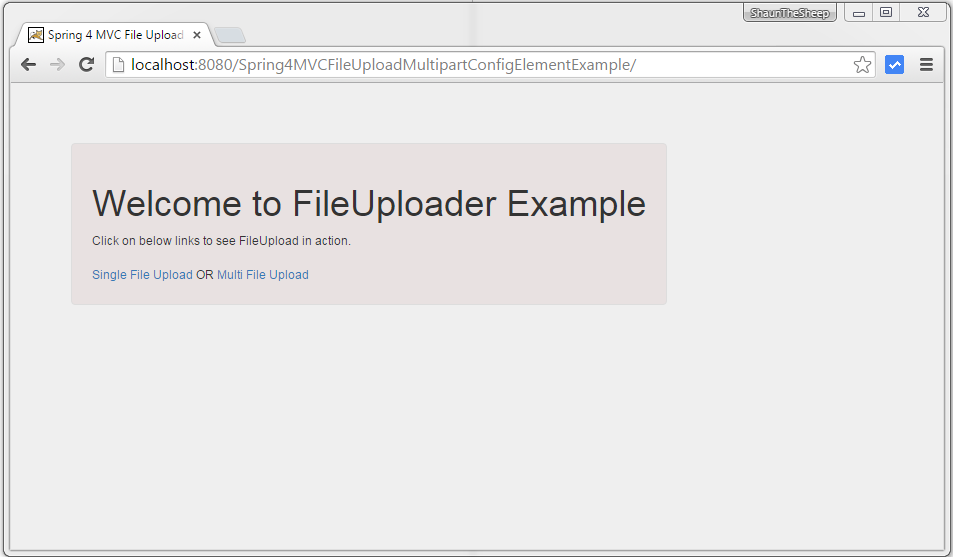
Now click on Single File Upload link.

click on Upload, without selecting a file. It should show validation failure message.
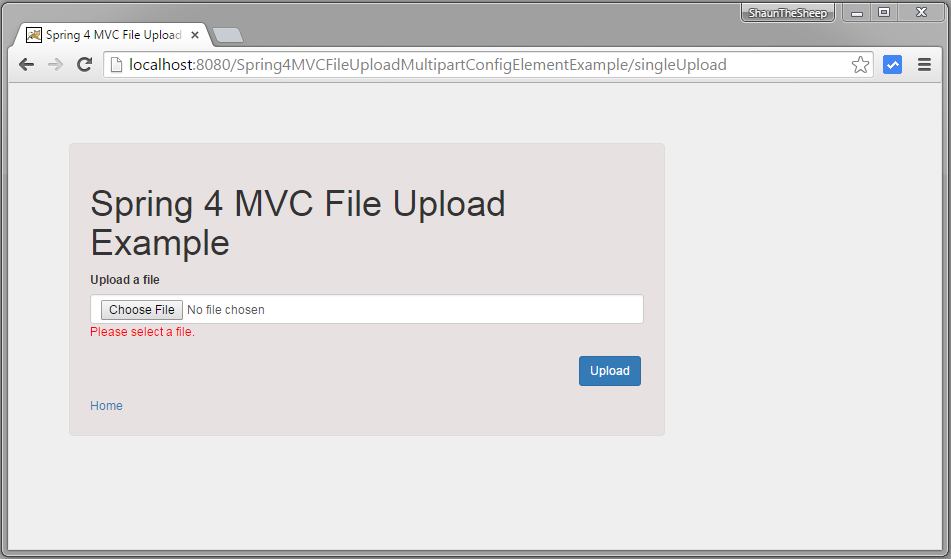
Click on Choose File.
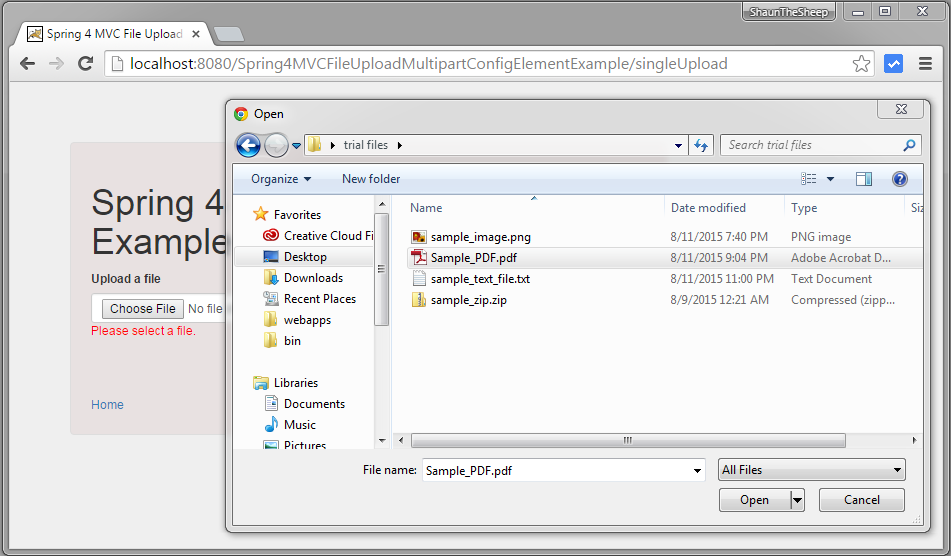
File picker should be shown. Select a file.
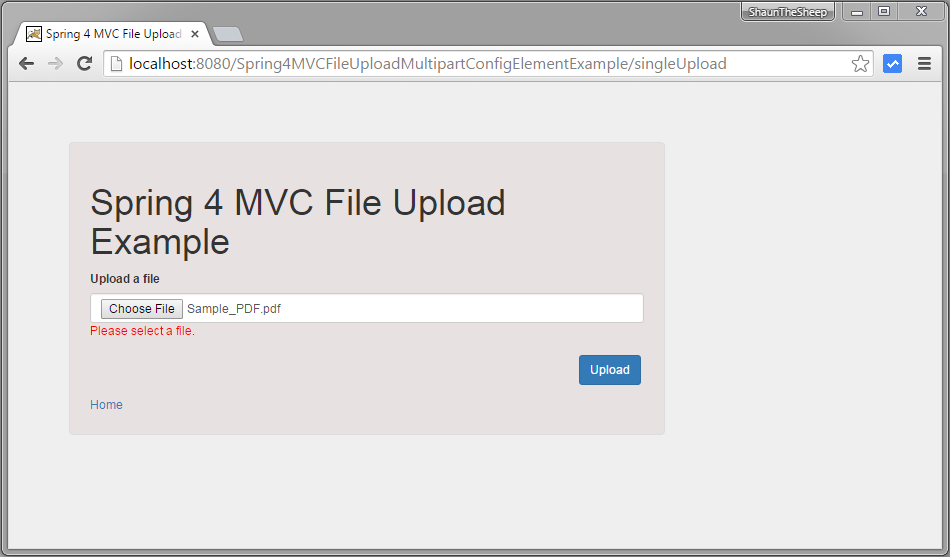
Clink on Upload. File uploaded.
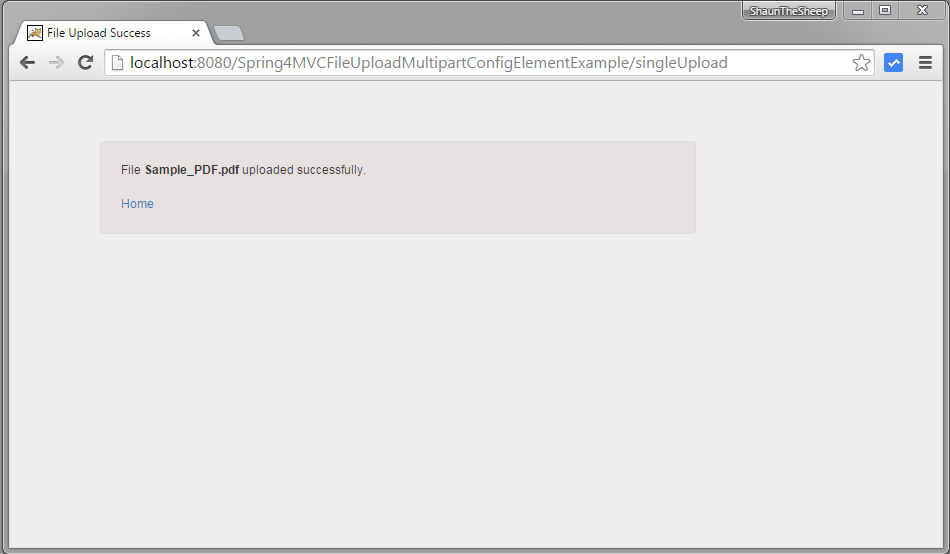
You can check Upload folder [C:/mytemp] for uploaded file.
Now Go back, and clink on multi upload link this time.

Click on upload without any file selection, should receive validation error.
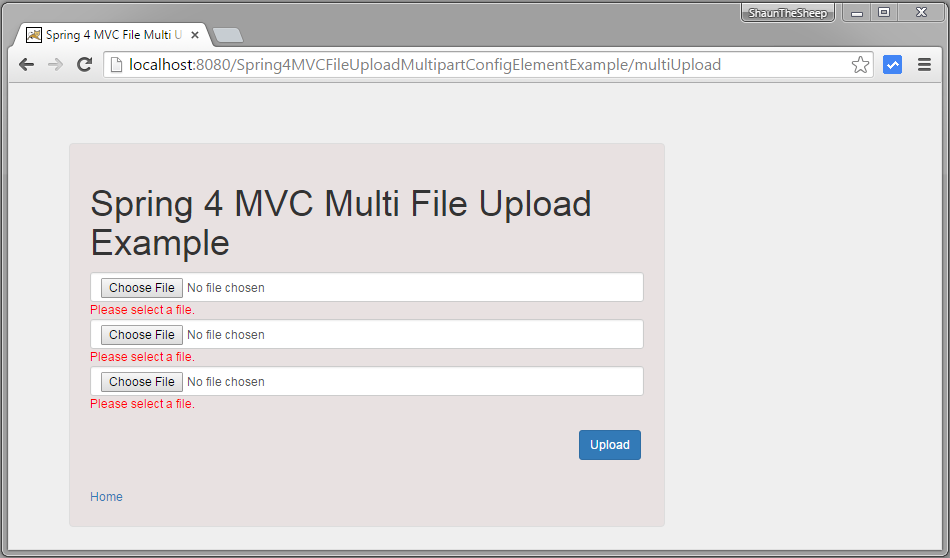
Select files.
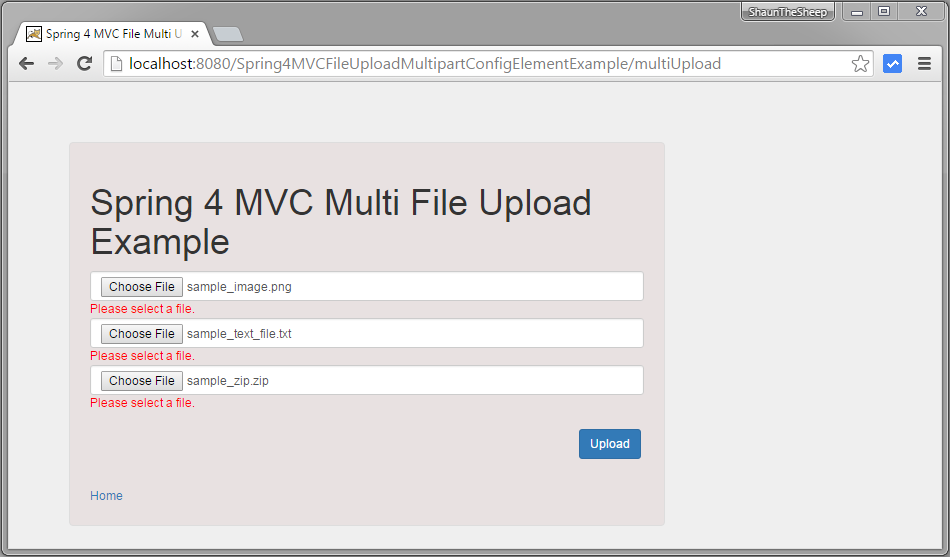
Clink on Upload. All selected files should be uploaded.
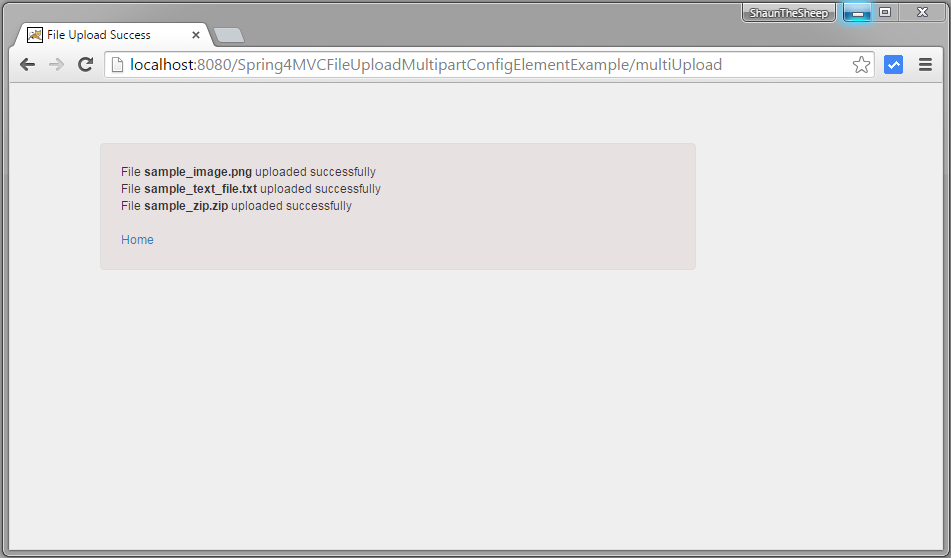
Finally check the storage folder [C:/mytemp].
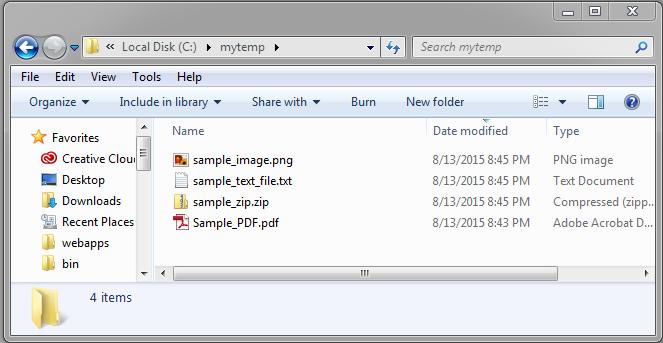
That’s it. Next post introduces File Download using Spring MVC 4.
Download Source Code
References
If you like tutorials on this site, why not take a step further and connect me on Facebook , Google Plus & Twitter as well? I would love to hear your thoughts on these articles, it will help improve further our learning process.